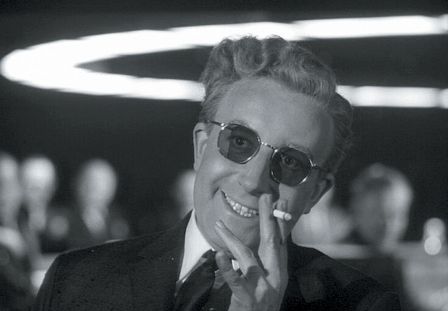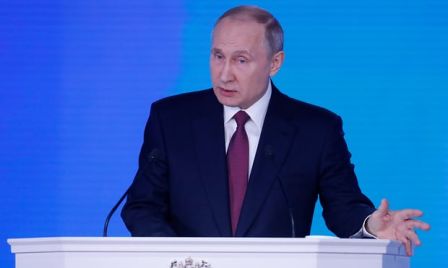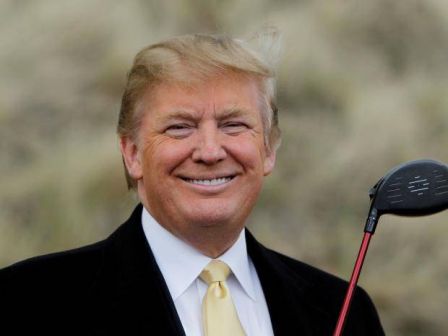(This is the English translation of an originally French text)
On March 1st, Russian president Vladimir Putin, speaking in front of the Federal Assembly, the largest gathering of Russian Federation leaders, spent a good third of his speech on the state of the country to glowingly describe new advanced nuclear weapons, announcing to the world that Russia now has extraordinary weapons, without equivalent in any other country, and reinforcing his words with many videos and enthusiastic adjectives.
Even if proximity of elections should be duly noted – Vladimir Putin is obviously campaigning for reelection – neglecting these news is impossible, for this is not about electoral marketing only. Why have the Russian government and armed forces leadership thought it necessary to invest in totally new versions of nuclear weapons, reminding the wildest concepts of the Cold War in the 1950s and 60s, which Stanley Kubrick’s Dr. Strangelove famously caricatured? Why does the Russian president think it necessary to announce them precisely now to Russia and the world?
To begin with, what is the credibility of his speech? Those futurist weapons have been represented with computer simulations dating back a decade, which is somewhat at variance with the crushing advance that Russian technology is supposed to have reached. Above all, the idea that Russia has done so much progress is too agreeable for too many people to be entirely above suspicion: not only the Russian public who would doubtlessly like to see their country leading the arms race, but also the US government and military-industrial complex, too happy to be given on a plate a pretext for even more defense spending (1). Russia has several times in the past realized remarkable technological feats – first satellite Sputnik, first man in space Yuri Gagarin, nuclear submarine with titanium hull, super-cavitation torpedo etc. But « Potemkin village » is also an expression from Russian origin, and Moscow several times demonstrated mastery of maskirovka, dissimulation and illusion as a war ruse.
One undoubtedly needs to take a closer look.
Why all these futuristic weapons and concepts à la Strangelove?
What is in fact most remarkable, the fundamental fact that must serve as basis to every discussion of Vladimir Putin’s speech, is that its declared objective, communicating most clearly to Americans that their dreams of effective antimissile shield and all the other Star Wars are but dreams, was already very largely done with Russian nuclear forces “normal” modernization in line with existing weapons, that is new Borei-type SSBNs, new mobile Topol ICBMs, at most replacement of fixed sites Voevoda with Sarmat ICBMs. Things were already perfectly clear and the Russian deterrent technical credibility could not be doubted, preventing any neocon-like firebrand nor illuminated partisan of world supremacy theories such as PNAC (Project for a New American Century) from missing it.
Why then all these additional nuclear weaponry programs? Here are a few possible rationales, which don’t exclude one another, and may all have contributed:
- Given continuous American efforts in the last three decades in the field of strategic antimissile, including very large R&D credits, Moscow has sought a guarantee against a potential American breakthrough – which didn’t take place, but the Russians couldn’t be sure in advance – in mode « Belt AND suspenders ». Not only modernization in relatively classical ways such as new and more stealthy SSBNs, mobile ICBMs, maneuvering warheads or South pole bound trajectories, but also several « exotic » projects like very long range heavy nuclear torpedo, nuclear propulsion for cruise missile or air-launched hypersonic missile
- Another part of the context: during maybe two decades, from beginning of 1990s to beginning of 2010s, Russia has not maintained continuous at-sea SSBN patrol (2) while a country like France has been maintaining it without interruption since 1974, and the United States for even longer. At the same time, new Borei-type SSBNs, while stealthier than the old Delfin, are generally thought to be somewhat less stealthy than their Western counterparts US Ohio, French Triomphant and British Vanguard, just like Russian SSNs. In other words, Russia had more reasons in the 1990s and 2000s to look for alternative ways to secure its second-strike capability than countries like the USA or France, and this may remain true in a certain – albeit limited – way
- Why has work on those projects continued once it became clear that US antimissiles remained just as little convincing as ever, while regular modernization of Russian nuclear forces was beginning to yield concrete operational results – first Borei SSBN, numerous mobile Topol missiles – let’s say in 2012 at the latest? Maybe acquired speed in bureaucratic fashion by R&D programs which were already in full swing, maybe a decision to work in mode « Belt AND suspenders AND tungsten-reinforced steel suspenders » in short to pile up securities upon other securities so as to – at last – feel protected. Maybe also a bit of techno-Promethean delusion, of which Americans don’t have a monopoly
- On another level, Moscow may seek to balance at least symbolically the « strategic partnership » with China that it aimed to develop largely starting 2014 following the Ukrainian civil war, a partnership which is uncomfortable for Russia because it’s about as balanced as a « strategic partnership » between France and the USA would be, a reality that Beijing doesn’t forget to take advantage of – gas contracts with prices favorable to China, retrieval of technology of the best operational Russian fighters for a pittance – and which Xi Jinping’s smiles won’t hide forever. From that point of view, when Vladimir Putin states that « Russia’s growing military power is a solid guarantee of global peace as this power preserves and will preserve strategic parity and the balance of forces in the world », he tries to suggest that Russia would play an indispensable role as balance to US power, a role that China does not play.
- Let us further cite Putin’s clear message following America’s recent Nuclear Posture Review decision to lower the « nuclear threshold » that is the conditions which would warrant US nuclear use, possibly with smaller power, in response to less dangerous attacks, even to a mere cyberattack! The Russian president has clearly stated that any nuclear weapon would be considered as such, whatever its power, which is a warning to the United States in case they would be tempted to switch to nuclear with a too light heart (4)
- Why did he announce precisely now the existence of these weapons? An obvious explanation is elections approaching! Two weeks before asking for reelection, telling the Russian population who has been fed continuous catastrophist propaganda on TV since 2014 that the US threat is definitively thwarted and Russia at last is outside of the danger zone is clearly interesting as electoral propaganda. Especially when material situation of most of Russian population remains very degraded when compared to the country’s wealth, this in large part because of oligarchs continuing to gather a disproportionate part of gas and oil wealth (3) and not forgetting to place it outside of the country

Herr Doktor Merkwürdige Liebe (Strangelove), electoral marketing consultant
"If with this you are not reelected in first round, Mister President!"
In addition to « why », the question of those nuclear armament programs reality and status is also open. Has Putin told a bit more than he intended to when he insisted heavily – maybe protesting too much
Now we have to be aware of this reality and be sure that everything I have said today is not a bluff ‒ and it is not a bluff, believe me

"Be sure that everything I have said today is not a bluff – and it is not a bluff, believe me"
And the question of operational interest of these programs is also open – assuming that they do exist, what do they bring to Russia’s defense?
Credibility and operational interest of Putin’s described weapons
Here is the detailed list of the six types of weapons described by the Russian president. Their credibility and operational interest are summed up with a color:
WEAPONS FOR NUCLEAR SECOND STRIKE
1. Super-heavy ICBM Sarmat – Green
Replacement for an existing system
Credibility – Very strong
When – Short / middle term
Operational interest – Moderate
This is a replacement for existing heavy ICBMs RS-36M2 Voevoda, planned to be operational a few years from now, whose existence was already public. Russia’s ability to develop and deploy such a weapon is above any doubt – this is straightforward modernization of existing hardware. Its operational interest lies first with its power which enables attack trajectories above the South Pole – bypassing US antimissiles – with a large payload, second with « penetration aids » that is the numerous decoys such a heavy payload enables to carry. That interest is however moderated by the fact that these fixed weapons would be vulnerable to a surprise first strike using powerful and precise warheads, which the United States do have. In other words, a US preventive attack would risk destroying them all, which limits their interest for nuclear deterrence.
2. Heavy intercontinental nuclear torpedo Status-6 – Orange
New system
Credibility – Moderate
When – Middle / long term
Operational interest – Moderate
Russia had already arranged for « leaks » about this new system. It would be very innovative, especially because of its very small nuclear reactor sporting a very high power-to-weight ratio – figures cited by Vladimir Putin are quite extraordinary « one hundred times more » that a nuclear submarine – as for high speed Russia already has experience with quick supercavitating Shkval torpedoes. The Russian president himself only speaks of being in a position to « start » developing an operational weapon on the basis of present tests. Note that going from a demonstrator to a fully operational weapon entails time, cost and technical risks… which will be overcome, or not, reinforcing the need to give it, at best, moderate credibility. Operational interest would be of course that this alternative means of reprisal would be very hard to counter. That interest is however moderated by the fact that such weapons would be vulnerable to surprise first strike if they were based in a harbor, or even in some subsea basis that foreign espionage may discover. Carrying them on a new type of SSBN why not, but that would entail high additional costs and probably specialized boats – then why not building three or four additional Borei SSBNs instead, probably for a lower price given that those boats are already operational, and at least as large a deterrent effect?
3. Nuclear-propelled cruise missile – Orange
New system
Credibility – Weak
When – Long term
Operational interest – Strong
This would be based on tests performed end last year. Again, Putin is speaking of « beginning » development, an operational weapon is not for tomorrow. This system is less credible than the previous one because constraints on the nuclear reactor, notably its mass, would be stricter for a missile than for a torpedo and because testing too would be more challenging – we’re speaking of a missile that would spread radioactive pollution continuously all along its trajectory! Russian territory is very large to be sure, but still… Inspiration for that system seems to be the US SLAM / Pluto from end 1950s, the era of all aspect no taboo no restriction nuclear weapons research, the time of Edward Teller the real life model for the character of Doctor Strangelove. The United States abandoned that project on the one hand because of technical difficulties with materials, on the other hand because operational real scale testing of such a missile would have been somewhat problematic!
Such a weapon would have a high operational interest as an alternative means of strike which could be based discreetly anywhere, invulnerable to a disarming first strike.
4. Intercontinental high hypersonic air-breathing missile Avangard – Red
New system
Credibility – Very weak
When – Long term
Operational interest – Strong
This would an extremely innovative system, sporting intercontinental range and Mach 20 speed. It is reminiscent of 1980s US project NASP (X-30) for a single stage space shuttle, which didn’t result in anything. So ambitious objectives would necessitate numerous breakthroughs including with materials, which didn’t take place in more than thirty years of research on hypersonic propulsion in various nations, supplied with enormous credits as far as the US are concerned. The idea that Russia would have suddenly performed all those breakthroughs has frankly very weak credibility.

Potemkin village and trompe l’oeil… at least for a large part
OTHER WEAPONS
5. Laser weapons – Orange
New system
Credibility – Moderate
When – Now?
Operational interest – Moderate
This announcement by Putin was remarkably imprecise: « Since last year, our troops have been armed with laser weapons »... yes, but which kind? Existence of operational blinding laser weapons in service with different technologically advanced armed forces is an open secret. If that’s what the Russian president was alluding to, then it was practically not news.
Other uses for more powerful lasers, e.g. for antimissile defense or air combat, are theoretically possible. However, a combination of concerns about embedded energy, required performance especially of optics, general reliability, logistics, finally limited range because of atmospheric scattering have prevented trials started at the latest in the 1980s to ever lead to an operationally deployed system. The US YAL-1 ABL project of an airborne antimissile laser, which has probably undergone the most extensive testing and received very large credits, never came into service. To be sure it cannot be excluded that Russian scientists performed a breakthrough, hence moderate rather than weak credibility – even if that may be a bit generous.
Operational interest too would be moderate. Of course in science-fiction movies a laser burst is described as a big ZAP and a target down in flames, but a real life laser would be nothing magical, its tactical effect would depend on counter-measures protecting the target – coating, self-rotation if it’s a missile – and its range would remain short except in rarefied high atmosphere, while its operational effect would anyway be limited by heavy logistical requirements.
6. Air-launched hypersonic missile Kinzhal – Green
New system
Credibility – Moderate
When – Now?
Operational interest – Strong
This is the most interesting announcement in Putin’s speech, and potentially very important news – if it’s not exaggerated, of course. Sarmat missiles (N°1) are a serious matter, they will be put into service, but they are not really new and won’t cause any upheaval – Russia is already protected by an effective nuclear deterrent based on Borei SSBNs and mobile Topol M ICBMs without need for such a system, whatever the Russian president may pretend to believe. The rest (N°2 à 5) is more or less advanced, more or less unbound not to say slightly crazy R&D, it’s difficult to imagine it entering service anytime soon, with a small chance yet for Status-6 heavy nuclear torpedoes. But Kinzhal does seem serious, announcement that it started testing December 2017 prior to service entry is relatively credible and operational impact may be very real – if, again, Vladimir Putin did describe a reality.
Let us first precise that the expression “hypersonic missiles” generates ambiguity, for « hypersonic » does not mean anything more than a speed larger than Mach 5 five times the speed of sound. Direct understanding of that expression would not be anything new, most ballistic missiles are hypersonic, and German V-2s of WW-II time already were! However, what is meant is in fact air-breathing hypersonic missiles, able to use ambient air for their motor even at these very high speeds. Here is the great technical challenge, here would also be the strong operational interest because an air-breathing hypersonic missile could freely manoeuver at speed greater than Mach 5, which would make it exceedingly difficult to intercept.
Clearly, such a highly maneuverable hypersonic (Mach 10) air-breathing weapon is what Vladimir Putin was alluding to. Is that credible? A few points to consider:
1.Research on such systems is active in the United States, France, China and Russia. For Moscow to be far ahead in that race is possible in principle – breakthroughs do exist in R&D programs, and Russia has obviously performed breakthroughs in the past, as already recalled
2.That would be a true feat. France, which has strong expertise in highly supersonic air-breathing missiles with strategic ASMP-A, intends to replace that weapon with a Mach 8 hypersonic missile the ASN4G... but aims to field that system by 2035. The French aerospace technology center ONERA states in its Strategic scientific plan 2016-2025 [French version, the English one is less detailed] that « Penetration of enemy defense with hypersonic speed missiles remain a major scientific and technological challenge. A very large number of disciplines must contribute, such as aerodynamics, propulsion, missile architecture, control and guidance. Challenges on materials also are very large » and answering those challenges will need to develop « knowledge on aerodynamics and aeroacoustics, materials science, energetics, systems engineering and massively use numerical simulation in order to produce the required breakthroughs ». In short, from the point of view of experts from the country with the higher speed operational supersonic air-breathing missile at Mach 3/4, there remains an enormous amount of work. If Russia indeed started December 2017 the trials of a Mach 10 hypersonic air-breathing missile, it means she has forged 15 years ahead of France, and of the United States who probably are about at the same point in this field
3.Reliability of the Russian president’s words can be doubted, given the many glowing announcements with weak credibility he made about other types of weaponry in the same speech. One should further note that on the images he showed the Russian Federal Assembly, the Kinzhal missile looked very much like a very well-known ballistic missile dubbed Iskander, merely adapted to be launched from an airplane… therefore, precisely a missile which is everything but air-breathing!
It remains possible that Kinzhal is really air-breathing and really close to actual commissioning, since very large Russian experience in supersonic missiles might have enabled a technological breakthrough giving Moscow such a large advance.
Characteristics asserted by Putin speed up to Mach 10, range 2,000 km and maneuvering ability could lead to a strategic upheaval: the ability to neutralize an aircraft carrier from very far away using only conventional weapons, without any nuclear use. Putin rightfully underlined that no existing naval antimissile system – American RIM-66 Standard, Franco-Italian Aster-30 – could counter such an attack.
If the Russian president did not exaggerate – admittedly, that’s a “if” – then Russia will soon have the ability to neutralize any aircraft carrier in the Eastern Mediterranean or the Persian Gulf from aircraft flying above the Black Sea or Caspian. Likewise for aircraft carriers in the Sea of Japan or the Yellow Sea from aircraft flying around Vladivostok or even Sakhalin. On the other hand, if Kinzhal is nothing else than a classical Iskander ballistic missile horizontally carried by a MiG-31 fighter – what he does look like – then it remains a possible means of attacking aircraft carriers, even if it would then potentially be much easier to intercept by existing US antimissile systems or middle term – Aster 30 Block 1 NT – French ones.
Note that even if Russia does not in fact have operational air-breathing hypersonic missiles, it may be in her interest to have others believe so, especially to increase her influence on third countries which may fear being attacked by groups of US aircraft carriers, such as North Korea, or even more Iran.
What next? What will Washington do?
Speaking of countries with independent global range nuclear deterrent, which outside of Russia are only three (5), not much reaction is to be expected from China nor France, both of whom aim at minimum format of nuclear deterrence, centered exclusively on guaranteeing the country’s vital interests. For Russia to acquire or not more numerous or different nuclear weapons is of no impact to those countries strategies, which build their respective deterrents on the basis of defense needs, not a requirement for « parity » with anybody. Moreover, both China and France have very sensible refrained from giving any « nuclear guarantee » to any foreign country, whereas the United States implausibly claim that they will endanger New York and Los Angeles – which are vital to them – by using nuclear weapons to defend Berlin or Tokyo which are not vital to the USA, while Vladimir Putin asserted just as implausibly that Russia’s deterrent would also be used for the benefit of her « allies ».
The United States do indeed live like Russia with the illusion that parity in numbers and technical characteristics of nuclear weapons would be meaningful by itself. Washington and Moscow do maintain between them more than 90% of the global nuclear weapons inventory, without any other reason than prestige, habit and military bureaucracies aiming to survive or even prosper whatever the country’s actual military needs may be. In those conditions, and since the United States are already increasing the already very copious financing of their armed forces, will they stand without reaction?
While it’s reasonable to expect Paris and Beijing to be encouraged to further their research on air-breathing hypersonic missiles, while existence of Kinzhal no matter whether air-breathing or not should incite reinforcement of the French aircraft carrier group antimissile protection beyond already decided modernization, along the lines of the 2011 report to the French Senate, it’s America that may react very strongly to this Putin speech which, more than a challenge, looks like a full-fledged provocation intended to incite a desire, and possibly a rage to respond.
Of course, the Kremlin spokesman has insisted that Russia does not aim at all to start a new arm race – contradicting in passing his president who said in his speech that an arms race did take place, and was now over with Russian victory by knockout – but it’s difficult to imagine Washington contenting itself with this declaration
"This is no more than a Russian answer to US withdrawal from the antimissile agreement and very active development process of a global antimissile system which may violate strategic nuclear parity and de facto neutralize Russian strategic forces ", said Mr. Peskov on Friday.
The United States, which in addition are a serious candidate for the Darwin Awards since their withdrawal from the ABM treaty in 2002 intended to enable development costing tens of billions of antimissile defenses with reliability so weak as to be ridiculous has only resulted in rapid move modernization of Russian nuclear forces and revival of military R&D in large part Potemkin as far as Putin’s recent speech is concerned but not entirely, will probably multiply their efforts – and expenses – to “catch up” and “close the gap”.
In addition to rationales of Putin’s speech already discussed above, should we add a hope to incite Washington to do precisely that, and sterilize a good part of US military R&D by attracting it in dead ends, attempting to reproduce fake technological feats?

Emmanuel has got his nice yearly military parade, Donald wants his own, even nicer!
Vladimir has got his new extraordinary nuclear weapons, will Donald want his own, even more impressive?
1 – Georgy Arbatov, member of Mikhail Gorbachev’s delegation on his first visit in Washington, had warned: « We are going to do something terrible unto you: we will deprive you of an enemy ». Vladimir Putin is certainly much better for the US MIC than diplomat Arbatov used to be…
2 – Sub-Sea Ballistic Nuclear, that is those submarines which carry nuclear ballistic missiles and are invulnerable to enemy first strike because they can’t be detected – that is, on condition that the submarine is stealthy enough
3 – Credit Suisse study of global wealth and its distribution shows that maximal wealth inequality – Gini coefficient larger than 90, on a scale going up to 100 – is reached among developed countries only in Russia and in Ukraine, worse even than the United States in this regard (source here, pages 106 and following)
4 – The French MP Emile Ollivier announced to the National Assembly the beginning of the 1870 Franco-Prussian war with these words: « We declare this war with a light heart »
5 – The United Kingdom has nuclear weapons with global range, but they are not independent from the United States, these are actually merely US SLBMs from the same operational batch used by US SSBNs – meaning that London’s very ability to order a nuclear strike without prior authorization from Washington can be put in doubt. Other nuclear-armed countries such as Israel, India, Pakistan and North Korea don’t have operational global range nuclear weapons – although Pyongyang is closing in very fast


